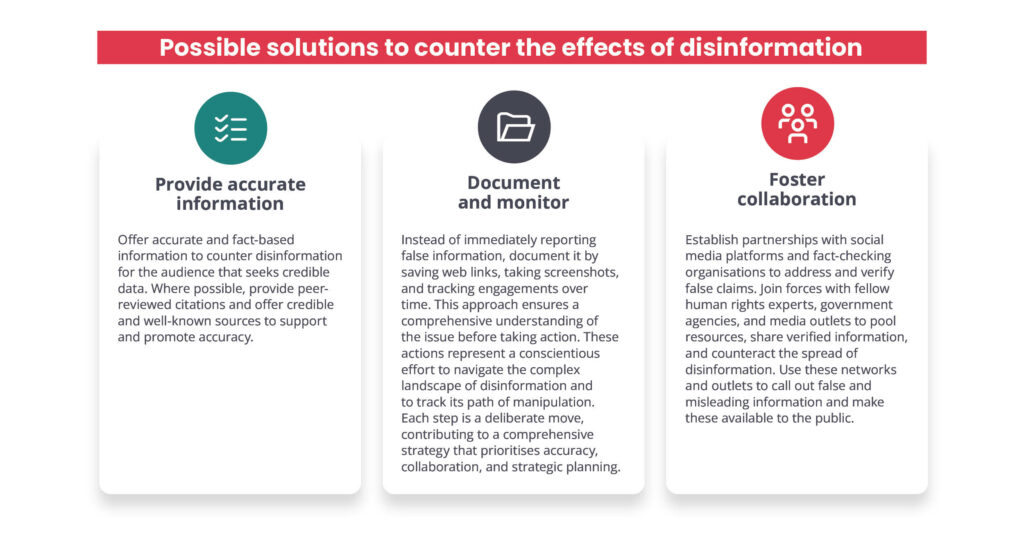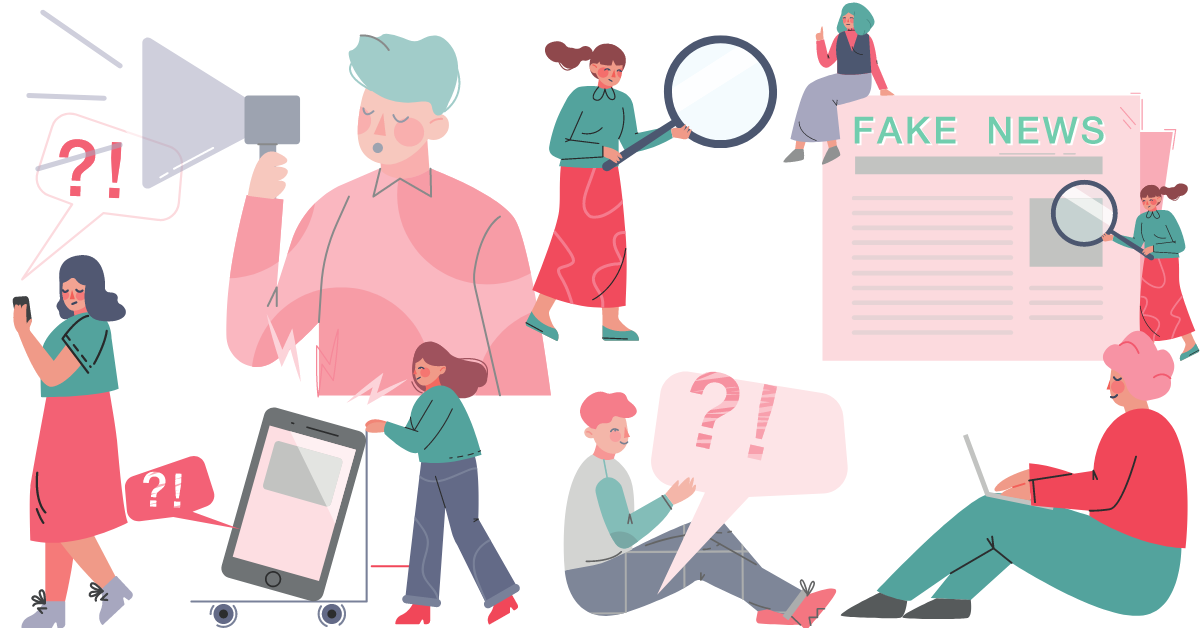Non-governmental organisations (NGOs) play a pivotal role in combating disinformation, as their work often revolves around issues that are vulnerable to manipulation and distortion. By harnessing the power of documentation and implementing effective solutions, NGOs can become a powerful force in the war against falsehoods.
Understanding the disinformation challenge
Disinformation is a malevolent influence and is defined as deliberately disseminating false or misleading information with the explicit intent of manipulating public opinion and causing harm(1). NGOs, often involved in issues that may be influenced by or are related to disinformation, need to comprehend the nature of this challenge.
Deceptive intent is a key characteristic of disinformation, as it is purposefully designed to mislead, typically with motives rooted in political, ideological, or economic interests, amplifying its inherent threat. Coordinated campaigns, orchestrated by both state and non-state actors, exploit weaknesses in the information ecosystem to propagate disinformation on a larger scale. This manipulation of information not only deceives, but also undermines trust, as disinformation acts as a corrosive force, eroding faith in institutions, fostering division within communities, and challenging the fundamental principles of human rights. That is why, the multifaceted nature of disinformation poses a significant risk to the integrity of information and the cohesion of societies.
The influence of disinformation extends beyond individual beliefs and society; it also intertwines with the critical realm of documentation, further highlighting the importance of meticulous record-keeping. The negative impact of disinformation on individuals and society has profound implications for civil society’s work.
The impact of disinformation
Between truth and deception, disinformation has the ability to produce complex notions or overlap with other profound consequences. Some of these include scepticism and uncertainty, societal divisions and polarisation, and the manipulation of emotions, illustrating how disinformation paints a challenging picture.
1. Scepticism and uncertainty: Disinformation thrives in an environment characterised by scepticism and uncertainty. Individuals become overly cautious and question the authenticity of information. In such an atmosphere, documentation can be a safeguard against disinformation. To counter this, critical thinking, rigorous sourcing and citing, and accurate record-keeping are all essential tools to counter doubt and provide credible, trustworthy information.
2. Division and polarisation: Disinformation plays a significant role in fueling societal divisions and polarisation. As society becomes more divided, there is a risk that individuals may become selective in their acceptance of information based on their pre-existing beliefs. Documentation must strive to present an objective and unbiased view of facts to bridge these divides, promoting transparency and trust.
3. Manipulation of emotions: Disinformation often exploits negative emotions, such as fear, anger, and distrust, to manipulate individuals into believing false or misleading information. To counteract this, documentation must provide a source of reliable, evidence-based information, mitigating the impact of emotional manipulation. In turn, disinformation has an undeniable impact on free speech and dialogue by disrupting the chain of fair exchange.
Possible solutions to counter the effects of disinformation
In addressing the challenges posed by disinformation, specific measures could be employed to safeguard the work of NGOs, journalists, civil society and human rights defenders (2).

Provide accurate information
Offer accurate and fact-based information to counter disinformation for the audience that seeks credible data. Where possible, provide peer-reviewed citations and offer credible and well-known sources to support and promote accuracy.
Foster collaboration
Establish partnerships with social media platforms and fact-checking organisations to address and verify false claims. Join forces with fellow human rights experts, government agencies, and media outlets to pool resources, share verified information, and counteract the spread of disinformation. Use these networks and outlets to call out false and misleading information and make these available to the public.
Document and monitor
Instead of immediately reporting false information, document it by saving web links, taking screenshots, and tracking engagements over time. This approach ensures a comprehensive understanding of the issue before taking action. These actions represent a conscientious effort to navigate the complex landscape of disinformation and to track its path of manipulation. Each step is a deliberate move, contributing to a comprehensive strategy that prioritises accuracy, collaboration, and strategic planning.
Disinformation, documentation and human rights
In the dynamic intersection of technology and human rights, a strategic approach to information becomes pivotal. To embrace the close connection between technology and the human rights framework, incorporating robust documentation practices becomes not only a necessity but a proactive step towards countering the challenges posed by disinformation. This entails the development of methodologies and ideas to strengthen the response.
Data and source verification
Ensure that the information collected and shared is well-documented, sourced, and traceable to reliable origins. Cross-referencing data and information from multiple sources helps in verifying the accuracy of the information. When discrepancies arise, they can be investigated and resolved.
Data integrity
Maintain a rigorous and consistent process for data collection and storage, preserving the integrity of information used in reports, publications, and campaigns.
Accurate reporting
NGOs should maintain meticulous records of their activities, data, and findings. This documentation ensures the accuracy of information disseminated, making it harder for disinformation to take root.
Evidence-based advocacy
NGOs can use well-documented evidence to support their advocacy efforts. This not only adds credibility to their claims but also enables them to counter disinformation effectively.
Transparency and open access
Openly sharing their documentation and methodologies demonstrates transparency and can help build trust with stakeholders and the public. Make documentation accessible to the public and stakeholders, allowing for independent scrutiny and verification.
Attribution and context
Document the context in which information is presented, enabling a nuanced understanding of complex issues and preventing its distortion.
Crisis preparedness
Develop robust crisis management protocols, ensuring a swift and effective response when subjected to disinformation campaigns. (See HURIDOCS’ Rapid Response Documentation Principles)
Leverage technology
Harness advanced technology, such as data analytics and AI, to monitor the propagation of disinformation and detect malicious activities that pose a threat to human rights principles.
In the words of HURIDOCS’ tech team lead, Tomas Andreu:
“There is no magic solution for this problem, most of what people live for and think are based on belief rather than factual information. That’s why, this is key to combating disinformation: establishing trusted sources so it can be used as a reference on ‘what to believe’. Often technological advancements act as a double-edged sword, depending on the hands of the actors. This is not a novel situation, but rather a classical tech race. Some people use AI to create deep fakes, some people use AI to detect deep fakes. At the end of the day, the balance resides in the capacity of society to place enough resources on the side of the balance that has a good deed, because we already know the side of the society that has a bad intention will always find its own way. What we need to be aware of is not being bystanders just witnessing the disaster, but actively engaging in countermeasures.
“As a society, it is our mandate to fund and support ‘white hat’ tech approaches to counter the “black hat” ones, with proper monitoring and accountability mechanisms, creating public goods that strengthen the civil society as a whole to become more resilient to the dangers of technology.“
In today’s interconnected world, disinformation is a cunning antagonist that threatens the very foundations of trust and truth. The battle against disinformation is ongoing and challenging but by adopting robust documentation practices and implementing innovative solutions, civil society can be instrumental in safeguarding their missions and building a more informed and resilient society.
(1) Kalathil, S. (2020). The Evolution of Authoritarian Digital Influence. JSTOR. Access at: https://www.jstor.org/stable/26940158
(2) Bennett, L. &Livingston S. (2021). The Disinformation Age: Politics, Technology, and Disruptive Communication in the United States. Cambridge University Press.
